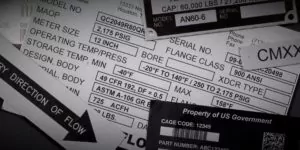What is a Conduit?
Organizations spanning nearly every industry rely on electrical wiring systems in their building, warehouse, or job site.
In order to better shield and guide the wiring, a tube called an electrical conduit is used. This rigid barrier not only protects the wire from damage, but also prevents the potential for electric shock to workers.
Conduits are made from a variety of materials to accommodate various needs. These pipes are typically marked with safety identification tags and labels.
Regulations
Outlined in the ASME A13.1 standard, guidelines for marking electrical conduits as well as other varieties of piping. OSHA highly recommends that organizations follow these standards.
In the A13.1 standard, there are specific guidelines for pipe marking. This includes a layout of color codes to represent various substances traveling through the pipes. For example, white text on a brown background signifies a combustible fluid.
Black text on an orange background is often used for electrical conduits, although this can vary by organization.
There are not many informational or sizing guidelines pertaining to electrical specific applications in the standard, as it is heavily focused on piping.
How Information is Applied
Electrical conduits marked with metal nameplates often use adhesive or straps to affix the tag to the pipe.
Vinyl or polyester labels are often used as they provide a quick and seamless method for marking the equipment. They can easily wrap around the contour of the piping and adhere with an industrial strength adhesive backing.
Some organizations utilize plastic tubes pre-marked with information, which just slips around the existing conduit.
Smaller tube conduits are very commonly marked with a metal cable tie, as it will easily wrap around the pipe and attach.
Information on the Conduit
Specific information which is marked on the conduit ranges from organization to organization. The most common data found on conduit tags is voltage level. This provides workers with the necessary information they need to monitor or service the wiring.
Marking Processes for Conduit Tags
Photo Anodization
Photo anodization is a highly versatile process, providing high customization coupled with industrial grade durability.
These tags can be marked with any information or design. This includes company logo, manufacturer information, and more.

This method produces custom nameplates with 20+ year durability. They are sturdy enough to withstand wear and tear, as well as exposure to weather or chemicals.
In addition, the anodization process allows for a solid color to be applied to the metal. This can help keep internal color coding consistent across piping and conduits.
Printing
One of the most commonly used methods for conduit marking, printing creates a custom design on a vinyl or polyester material.
The finished labels are flexible enough to wrap around pipes, allowing for the adhesive to bond to the surface without any additional hardware.
The downside to printing is that the ink tends to fade and wear over a period of time, especially if exposed to chemicals or other harsh conditions.
Etching
Etching uses a chemical process to create a slight indentation in a metal substrate. This is a durable method, as typical wear will not easily remove the marking from the surface.
After the tag is etched, a color infill is often add to provide a stronger contrast, making the design stand out. Keep in mind, this color fill will wear much faster than the etching itself.
Stamping
Variable stamping has been used historically in the electrical industry, although it can be a less economical solution than other processes.
Wrap-Up
Conduits are an essential component for organizations which rely on electrical systems. They not only aid in routing wiring, but also protect it from damage.
Conduit tags and labels aid in safety as they clearly identify which pipes are housing electrical wiring. They help workers and inspectors by indicating the voltage of the underlying wires.
The combination of electrical conduit and accompanying identification is essential to a safe operation.